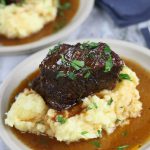
Red Wine Braised Short Ribs
Red wine braised short ribs have melt-in-your-mouth tender beef with a rich red wine sauce. This hearty, savory, and indulgent dish is perfect companion for mashed potatoes, creamy polenta or butter noodles.
Servings 6 servings
Calories 665kcal
Ingredients
- 5 pounds bone-in short ribs (English style cut short ribs) *see Note #1 below
- salt and pepper
- 3 tablespoons high heat oil *such as avocado oil
- 1 large brown onion *roughly chopped
- 1 large carrot *roughly chopped
- 1 large celery stalk *roughly chopped
- 6 large garlic cloves *minced or crushed
- 3 tablespoons tomato paste
- 2 1/2 cups red wine *see Note #2 below
- 5-6 cups beef broth
- 2 bay leaves
- 2 fresh rosemary sprigs
Instructions
Salting the Ribs
- Dry ribs with paper towels and remove the silver skin from the bone side of the rib. See Note #1 below for step by step instructions.
- Salt snd pepper all sides of the ribs and lay flat in a single layer on a sided cookie sheet lined with a rack. Refrigerate overnight or up to 24 hours. Note: It is ok to sear immediately after salting if short on time.
Searing the Ribs
- Heat a dutch oven or large skillet pan over medium-high heat with oil. Working in batches sear ribs on all sides, approximately 2-3 minutes per side.
- Remove ribs and set aside. Pour off excess grease leaving behind 2-3 tablespoons.
Preparing the Braise
- Preheat oven to 325℉.
- Keeping the pan on the same medium-high heat, add the roughly chopped onion, carrots and celery. Sauté until lightly browned, about 5-7 minutes.
- Add garlic and tomato paste. Cook stirring constantly until vegetables are coated and turn a deep red color, about 5 minutes.
- Stir in wine and deglaze pan by scraping up the fond (brown bits of flavor) sticking to the bottom of the pot. Stir in beef broth.
- Transfer beef back in pot. Add bay leaves and rosemary.
- Bring to a simmer and then cover and transfer to oven. Cook for 1 hour, remove pan from oven and flip ribs. Cover and cook for an additional hour or until ribs are tender.
Making the Sauce
- Transfer ribs to a platter and cover with aluminum foil.
- Strain sauce through a fine mesh strainer and discard veggies.
- Add liquid back to pot and reduce over medium heat, about 10-15 minutes. Spoon excess fat from surface of sauce and then taste test to see if additional salt or pepper is needed. See Note #3 and #4 below.
- Add beef back to pan to reheat, about 3-5 minutes.
- Serve over mashed potatoes, buttered noodles or creamy polenta.
Video
Notes
Recipe Notes
Note #1- How to remove silver skin off of ribs:
- Place rib bone-side up. Locate white membrane covering it.
- Start peeling up membrane at one end using fingers. Note: A small knife may be needed to begin lifting the skin.
- Grip freed edge and slowly pull membrane off, peeling it away from meat.
- Keep peeling back until entire membrane is fully removed.
- Discard membrane. Rinse rib and pat dry.
- Cabernet Sauvignon – This full-bodied red has nice acidity and bold fruit flavors that complement the beef. A classic choice.
- Merlot – Merlot brings cherry and plum notes and soft tannins to balance the rich ribs.
- Malbec – Deep ripe fruit flavors like plum and dark cherry work well with short ribs. Affordable too.
- Zinfandel – Jammy berry flavors and black pepper spice pairs nicely. Not too tannic.
- Syrah/Shiraz – Full tannins provide structure and peppery flavor to the sauce.
- Blends like Bordeaux – Blends balance light and heavy notes in the wine and ribs.
- Remove ribs from braising liquid and allow to cool slightly before storing.
- Store ribs and braising liquid in serrate air tight containers.
- The next day the fat will rise to the surface of the braising liquid and will be solidified.
- Remove the solidified fat and discard.
- Reheat gently either on the stovetop over medium-low heat or baked in a 350°F oven. This will bring the ribs up to temperature slowly to maintain moisture and prevent drying out.
- Cook just until heated through, about 15-20 minutes. Don’t overcook.
- Make a slurry by mixing 1/2- 1 tablespoon cornstarch with an equal amount of water. Stir it into the simmering sauce until thickened.
- Make a paste of 1 tablespoon of softened butter with 1 tablespoon of flour. Stir it into the simmering sauce until thickened.
- Puree vegetables from the braise and stir them back in to act as a natural thickener.
Nutrition
Calories: 665kcal | Carbohydrates: 9g | Protein: 56g | Fat: 36g | Saturated Fat: 13g | Polyunsaturated Fat: 3g | Monounsaturated Fat: 17g | Trans Fat: 0.03g | Cholesterol: 163mg | Sodium: 1001mg | Potassium: 1390mg | Fiber: 1g | Sugar: 3g | Vitamin A: 2136IU | Vitamin C: 5mg | Calcium: 61mg | Iron: 7mg